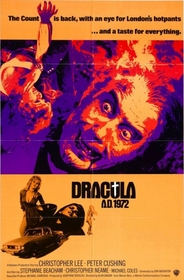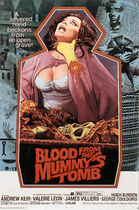Our editor-in-chief Nate Yapp is proud to have contributed to the new book Hidden Horror: A Celebration of 101 Underrated and Overlooked Fright Flicks, edited by Aaron Christensen. Another contributors include Anthony Timpone, B.J. Colangelo, Dave Alexander, Classic-Horror.com's own Robert C. Ring and John W. Bowen. Pick up a copy today from Amazon.com!
Dracula A.D. 1972 (1972)
In a desire to reach the young market, Hammer Films put out the movie that many consider an atrocity in the Hammer Dracula series. Dracula 1972 A.D. was meant to breath new life into the classic horror monster, even though there was nothing really wrong with him to begin with. What we are left with is a film that can’t decide whether it’s a teen flick or a serious horror film, but still has enough likeable aspects to make it an enjoyable Hammer Dracula flick.
This story takes place 100 years after Dracula in the psychedelic 70’s. A hipster by the name of Johnny Alucard decided to conduct a secret ritual that will resurrect Dracula (because I suppose no one will notice a guy in a black cape walking around what with all the 70s pimps around and whatnot). Dracula, played by Christopher Lee, decides that while he’s in town, he’s going to murder Van Helsing’s relatives. Just because. Yeah, I know it doesn’t make any sense, but, hey! Peter Cushing is the leader of the Van Helsing clan and at least that’s something.
The ultimate problem, and coincidentally the ultimate asset, to the film is that it is so afraid to let go of the gothic horror atmosphere that Hammer is known for while still trying to be modern. Hammer purists will completely hate this film because of the modern undertones. But if you can buy into the fact that you are going to watch the ultimate 1970s parody with vampires spliced in, then you’ll probably dig it. For me, the 1970s stuff mostly worked, but there were some bumpy points. For example, all the over-the-top swinger scenes in the beginning of the film made it difficult for me to really have sympathy for the main characters as they just seemed stupid and reckless. And the Satanic ritual -- which was suppose to be reminiscent of the old-school Dracula -- looked horrendously out of place with the bell-bottoms and 70’s verbiage. However, Dracula A.D. 1972 seemed to come through when it counted, namely in one particular scene near the climax when Van Helsing’s daughter is about to be attacked by two vampires. The creepy-disco music meshing with the right blend of neon lights made an otherwise all-too-familiar scene look fresh and eerie.
But, again, there was problems with score as well, namely at the actual climax with Cushing and Lee. The setting is in a castle, everyone is dressed in classic gothic garb (which is understandable for everyone in the scene besides Peter Cushing -- clearly it was laundry day for him), but instead of making the wiser choice and going with the classic Hammer gothic movie score, creepy-disco music came back and it took away from the scene a bit. Until that music played, I didn’t even question why Peter Cushing was wearing clothing reminiscent of 1872 or why there was a castle in the 1970s or why the 70s looked so gothic to begin with. But then the music reminded me where we were supposed to be, and those questions arose. Ultimately, it didn’t make much difference as the action in the climax was on par with every other Dracula film, but it would have been stronger with a different musical choice.
But, I have to give Dracula 1972 A.D. props where props was due. Every scene with Lee, from a purely visual standpoint, was beautiful. There were plenty of lingering shots, panning upwards so that he looked 8-feet tall, and a completely breathless scene where his cape is blowing behind him as he is gazing out the window while a haunting green light shines down on him overhead. Very nice work. It was a nice contrast to the Peter Cushing shots -- soft scholarly lighting with a focus on his intense blue eyes, so the audience knew he too was a powerful force to be reckoned with. Terence Fisher would have been proud.
If you’re deciding whether to watch this movie, first ask the question…”Could I really buy into this premise?” Does the thought of Christopher Lee’s Dracula in the 1970s cause your body to start producing an overabundance of spleen secretions? If so, well, then you’d probably be best to stay away. If you‘re more open to the concept, give it a shot. Though inconsistent and choppy at points, Dracula 1972 A.D. is an enjoyable vampyric romp well-deserving of the Hammer name.








